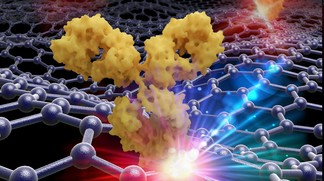Researchers at EPFL and ICFO have designed a graphene sensor capable of detecting molecules such as drugs and proteins. This device is the first of its kind to harness the unique optical and electronic properties of graphene for a practical application.
 Copyright 2015 EPFL/Miguel Spuch/Daniel Rodrigo
Copyright 2015 EPFL/Miguel Spuch/Daniel Rodrigo
Due to the amazing properties of graphene, this material holds promise in several areas of fundamental scientific research. As graphene consists of a single layer of carbon atoms, it exhibits very good electrical and thermal properties, in addition to being robust and light.
A team of researchers from Bionanophotonic Systems Laboratory (BIOS) of EPFl and the Institute of Photonic Sciences (ICFO, Spain) have succeeded in using graphene to create a reconfigurable, high-sensitivity molecular sensor.
In this work, graphene was used to improve infrared absorption spectroscopy, a familiar molecule detection technique. In the standard technique, light is used for excitation of molecules, which vibrate in a different manner based on their nature. This is similar to a guitar string that creates varied sounds based on its length. Due to this vibration, the molecules reveal their presence and their identity. It is possible to read this signature in the light reflected.
Detection of nanometrically sized molecules is not effective with the standard technique. The infrared photon’s wavelength focused on a molecule is 6µm (6000nm to 0.006mm), whereas the target size is just a few nanometres around 0.000001mm.
Sensing a molecule of this size in reflected light is truly a challenge. Graphene can address this challenge. When the right geometry is specified, graphene can help focus light on the right spot on its surface to 'hear' the vibrations of nanometric molecules coupled to it.
“We first pattern nanostructures on the graphene surface by bombarding it with electron beams and etching it with oxygen ions,” said Daniel Rodrigo, co‐author of the publication. “When the light arrives, the electrons in graphene nanostructures begin to oscillate. This phenomenon, known as ‘localized surface plasmon resonance,’ serves to concentrate light into tiny spots, which are comparable with the dimensions of the target molecules. It is then possible to detect nanometric structures.”
Further to the identification of nanometric molecules, this process can reveal the nature of bonds linking the atoms that the molecules are made of. Molecular vibration does not produce only one kind of “sound”. A molecule generates a range of vibrations based on the nature of bonds coupling the different atoms.
Similar to the guitar, there is a difference in vibration for each string and collectively they form a single musical instrument. These tiny details offer data on how each bond behaves as well as about the health of the complete molecule.
“These vibrations act as a fingerprint that allow us to identify the molecule; such as proteins, and can even tell their health status” said Odeta Limaj, another co-author of the publication.
A complete range of frequencies should be identifiable in order to determine the sound given by each string. This is possible using graphene. The researchers applied voltage to 'tune' graphene to varied frequencies, which cannot be done with currently available sensors.
Oscillating graphene’s electrons in several ways helped to read all molecular vibrations on its surface. “We tested this method on proteins that we attached to the graphene. It gave us a full picture of the molecule,” said Hatice Altug.
According to the researchers, this novel graphene-based process is a key advancement for a number of reasons. With this simple technique, it is possible to perform a complicated analysis with just a single device without modifying or affecting the biological sample.
“There are many possible applications,” said Altug. “We focussed on biomolecules, but the method should also work for polymers, and many other substances,” she added.
The research findings have been published in the journal Science.